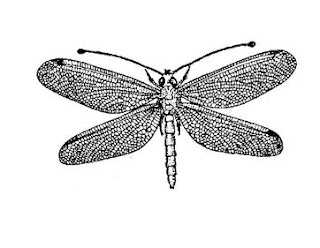Endopterygota: Coleoptera & Neuroptera
Endopterygota (Holometabola)
Order COLEOPTERA
Beetles
Coleo – Stony
Ptera – Wings
•
Largest order
in animal kingdom comprising 25% of all animal species
•
40% of known
insects are beetles
•
Predatory,
phytophagous, saprophagous
1. Chewing mouth parts, well developed mandibles
2. Fore wings – elytra, not used in for flying, hind
wings-membranous, folded beneath elytra
3. Larval stages called as grubs
4. In most species, abdominal tip not covered by
elytra and is called pygidium
Sub-order:
Adephaga
1.
Family: Carabidae
Ground beetles
•
Shiny, flat,
black beetles with slender, long legs
•
Antennae
arise laterally on the sides of the head between eyes & mandibles
•
Head narrower
than pronotum
•
Elytra with
grooves or lines
2.
Family: Cicindelidae
Tiger beetles
•
Adults and
grubs with sharp mandibles & long legs
•
Antenna arise
from the anterior part of head, above mandibles
•
Head broader
than pronotum
•
Elytra –
brightly spotted or striped
3.
Family: Dytiscidae
Predaceous diving beetles
•
Smooth, oval,
shiny, aquatic beetles with long, filiform antenna
•
Hind legs
flat, fringed with long hairs, oar like, swimming type (natatorial)
Sub-order:
Polyphaga
4.
Family: Hydrophilidae
Water scavengers
•
Oval, smooth,
shiny, convex
•
Short,
clubbed antenna
•
Metasternum –
sharp spine like
•
Hind legs –
natatorial (swimming)
•
Plastron
respiration by chamber under abdomen
5.
Family: Scarabaeidae
Scarab beetles, Dung rollers
• Lamellate antenna
• Exposed Pygidium
• Spines or horns on
head or prothorax
6.
Family: Melolonthidae
June beetles, chaffers
• Stout with shiny elytra
• Adults attracted to light
• Larvae – scarabeiform
• White coloured with brown head, thus called white
grubs
• Feed on roots, thus called root grubs
7.
Family: Dynastidae
Rhinoceros beetles, Hercules beetle,
Atlas beetle
•
Largest of
all beetles
•
Most species
with horn on head
•
Sexual
dimorphism
•
Scarabaeiform
larvae
8.
Family: Lucanidae
Stag beetles
•
Large, brown
or black
•
Geniculate
antenna
•
Males larger
than females
•
Males with
long, branched horn like growth
9.
Family: Rutelidae
Shining leaf chaffers
•
Metallic,
shiny
•
Blue, green,
brown, yellow or red
•
Pests of
forest trees and other plants
•
Grubs feed on
roots while adults on foliage
10.
Family: Staphylinidae
Rove beetles
•
Slender, elongate, very short elytra
•
Abdomen
flexible, moved up and down
•
Resemble
earwigs but lack cerci
11.
Family: Buprestidae
Jewel beetles, metallic wood boring
beetles, flat headed borers
•
Metallic, shiny elytra and body
•
Small head,
sunken into thorax
•
Prothorax
expanded
•
Grubs –
legless with flat head bore beneath tree bark
12.
Family: Elateridae
Click beetles
•
Elongate,
cylindrical
•
Pronotum with
sharp spines at the bottom
•
Jump into air
with “clicking” noise, when placed upside down
•
Grubs –
slender, resembling rusted wire, called wire worms
13.
Family: Lampyridae
Fireflies, Glow worms
• Flat, elongate, nocturnal
• Males – winged, well developed eyes
• Females – wingless, larviform, reduced eyes
Light production by Luciferin, when oxidized
in the presence of luciferase
14.
Family: Coccinellidae
Lady beetles, Lady bird beetles
• Hemispherical, convex
• Head – small, inside a notch in prothorax
• Elytra – spotted or banded with bright colours
• Grubs – campodeiform
• Predaceous except one species on eggplant
15.
Family: Meloidae
Blister beetles
•
Deflexed head
•
Narrow neck,
long legs
•
Reflex
bleeding through various joints
•
Haemolymph
has cantharidin that causes blisters on skin
16.
Family: Chrysomelidae
Leaf beetles
•
Elongate or oval
•
Short clavate antenna
• Tortoise
beetles (Cassidae)
•
Leaf beetles (Galerucidae)
•
Flea beetles (Alticidae)
17.
Family: Cerambycidae
Long horned beetles / Longicorns
•
Cylindrical,
very long serrate antennae
•
Compound eyes
– notched
•
Pronotum with
lateral spines
•
Grubs –
elongate, apodous, called round headed borers
18.
Family: Bruchidae
Pulse beetles, Seed beetles
•
Small, short,
egg shaped
•
Serrate
antenna
Short elytra, do not cover abdomen.
19.
Family: Cetoniidae
Flower chaffers
•
Brightly
coloured
•
Lamellate
antenna
•
Larvae –
scavengers
•
Goliath
beetle – Heaviest insect
20.
Family: Curculionidae
Weevils, Snout beetles
•
Head
prolonged into snout or beak
•
Mandibles at
the tip of the snout
•
Geniculate
antennae
Other
important families
•
Tenebrionidae –
Red flour beetle
•
Bostrychidae –
Lesser grain borer
•
Anobiidae –
Cigarette beetle
•
Dermestidae – Carpet beetle
•
Lyctidae –
Powder post beetle.
Order Neuroptera
Lacewings,
antlions, owlflies, alderflies, snakeflies, dobsonflies
Neuro – Nerve
Ptera – wings
•
Both larvae
& adults - Predaceous
•
Mouth parts –
chewing or mandibulo - suctorial
•
Compound eyes
- Large
•
Wings –
similar, membranous with extensive venation
•
Larvae –
campodeiform with sickle like mandibles
1.
Suborder Raphidioidea (Snakeflies)
2.
Suborder Megaloptera (Dobsonflies)
3.
Suborder Planipennia (Antlionflies, Lacewings, Owlflies)
Family
Raphidiidae
Snakeflies
•
Elongate,
slender, neck like thorax
•
Membranous
wings with pterostigma
•
Larvae with
strong mandibles
Family
Corydalidae
Dobsonflies,
fishflies
•
Aquatic,
large
•
Hind wings
broader than fore wings
•
Larvae as
fish baits.
Family
Chrysopidae
Aphid
lions, green lace wings, golden eyes
•
Metallic
green body and lace like wings
•
Golden yellow
coloured eyes
•
Few emit bad
smell, thus called stink flies
•
Pedicellate
eggs
Family
Hemerobiidae
Brown
lace wings
•
Brown
coloured, smaller than gree lace wings
•
Moniliform
antenna
Family
Myrmeliontidae
Antlionflies
•
Long, narrow,
spotted wings
•
Resemble
damselflies
•
Short, thick,
knobbed antenna
•
Grubs – in
conical pits, sickle like mandibles (mandibulo-suctorial mouth parts)
Family
Mantispidae
Mantispidflies
•
Resemble
praying mantids
•
Elongated
prothorax
•
Raptorial
fore legs
Family
Ascalaphidae
Owlflies
•
Resemble
dragonflies
•
Clubbed
antenna
•
Long fine
hairs on head
•
Pterostigma
Order Mecoptera
Scorpionflies
Meco – long
Ptera
- wing
• Predaceous, terrestrial
• Head prolonged, beak like
• Filiform antenna
• Short cerci
• Long, slender male genitalia, resembling sting of
scorpion
















































































Comments
Post a Comment